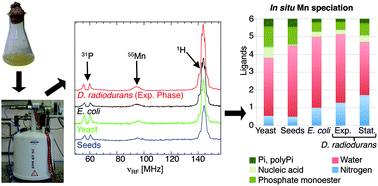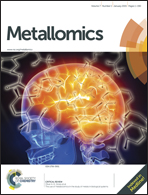Variations in Mn(ii) speciation among organisms: what makes D. radiodurans different
Abstract
The manganese(II) speciation in intact cells of D. radiodurans, E. coli, S. cerevisiae and Arabidopsis thaliana seeds was measured using high-field electron paramagnetic resonance techniques. The majority of the Mn(II) ions in these organisms were six-coordinate, bound predominately by water, phosphates and nitrogen-based molecules. The relative distribution of the different phosphates in bacteria and S. cerevisiae was the same and dominated by monophosphate monoesters. Mn(II) was also found bound to the phosphate backbone of nucleic acids in these organisms. Phosphate ligation in Arabidopsis seeds was dominated by phytate. The extent of nitrogen ligation in the four organisms was also determined. On average, the Mn(II) in D. radiodurans had the most nitrogen ligands followed by E. coli. This was attributed to higher concentrations of Mn(II) bound to proteins in these species. Although constitutively expressed in all four organisms, MnSOD was only detected in D. radiodurans. As previously reported, D. radiodurans also accumulates a second abundant Mn containing protein species. The high concentration of proteinaceous Mn(II) is a unique feature of D. radiodurans.


 Please wait while we load your content...
Please wait while we load your content...